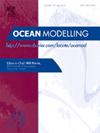研究北大西洋极端浪涌变化和趋势的长期海平面后验(1900-2015)
IF 2.9
3区 地球科学
Q2 METEOROLOGY & ATMOSPHERIC SCIENCES
引用次数: 0
摘要
极端海平面的变化,加上沿海人口的增长,是评估沿海洪水风险的关键因素。因此,研究造成极端海平面的主要因素风暴潮的变化和趋势,对海岸保护政策至关重要。我们在北大西洋开发了第一个覆盖整个20世纪(1900-2015)的0.1°网格小时浪涌后cast,并称为ClimEx后cast。我们用34个长期潮汐计验证了预测结果。该模型显示浪涌的总体性能非常好(均方根误差平均为9.3厘米),对于极端浪涌的性能也很好,尽管总体上被低估了。为了研究风暴潮的变异性和趋势,我们对模拟和观测的风暴潮进行了非平稳极值分析。风暴潮的季节性在很大程度上取决于该地区。季节性振幅从典型的10厘米到北海的40厘米以上不等。风暴潮季节发生在12月至1月左右的北纬40°以上地区,主要受冬季热带外气旋的影响,而西南地区则在9月至10月左右,主要受热带气旋的影响。风暴潮与北大西洋涛动的相关性从海岸向深海延伸,在50°N以上为正,在50°N以下为负。观测到的风暴潮大多显示不显著或很小的趋势(±1毫米/年),而模式几乎在所有地方显示正趋势,可能是由于1950年以前大气强迫数据集的不均匀性。本文章由计算机程序翻译,如有差异,请以英文原文为准。
A secular sea level hindcast (1900–2015) to investigate extreme surges variability and trends in the North Atlantic
Changes in extreme sea levels, combined with the growth of coastal population, are critical factors in evaluating the risks related to coastal flooding. Thus, studying the variability and trends of storm surges, a major contributor to extreme sea levels, becomes essential for coastal protection policies. We developed in the North Atlantic the first hourly surge hindcast covering the full 20th century (1900–2015) on a 0.1°grid, and called ClimEx hindcast. We validated the hindcast against 34 long-term tide gauges. The model shows overall very good performance for surges (Root Mean Square Error of 9.3 cm on average), and good performance for extreme surges, despite an overall underestimation. To investigate the variability and trends in storm surges, we performed a non-stationary extreme value analysis on modeled and observed storm surges. The seasonality of storm surges is highly dependent on the area. The seasonal amplitude varies from typically 10 cm, to more than 40 cm in the North Sea. The storm surge season occurs around December–January in the north of the domain (above 40°N), due to winter extra-tropical cyclones, and around September–October in the south-west, due to tropical cyclones. The dependence of storm surges with the North Atlantic Oscillation extends from the coasts to the deep ocean, and is positive above 50°N and negative below. Observed storm surges show mostly non significant or small trends ( 1 mm/yr), while the model displays positive trends almost everywhere, possibly due to inhomogeneities in the atmospheric forcing dataset prior to 1950.
求助全文
通过发布文献求助,成功后即可免费获取论文全文。
去求助
来源期刊

Ocean Modelling
地学-海洋学
CiteScore
5.50
自引率
9.40%
发文量
86
审稿时长
19.6 weeks
期刊介绍:
The main objective of Ocean Modelling is to provide rapid communication between those interested in ocean modelling, whether through direct observation, or through analytical, numerical or laboratory models, and including interactions between physical and biogeochemical or biological phenomena. Because of the intimate links between ocean and atmosphere, involvement of scientists interested in influences of either medium on the other is welcome. The journal has a wide scope and includes ocean-atmosphere interaction in various forms as well as pure ocean results. In addition to primary peer-reviewed papers, the journal provides review papers, preliminary communications, and discussions.
 求助内容:
求助内容: 应助结果提醒方式:
应助结果提醒方式:


